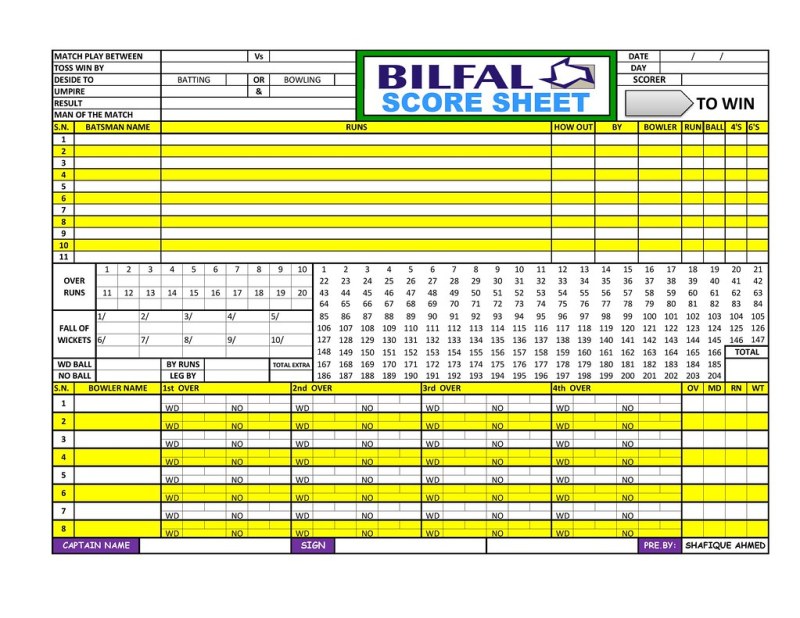
Cricket Score In English
Cricket Score In English – This article is about recording the events of a cricket match. For the player scoring process, see Running (Cricket).
In cricket, a scorer is the person appointed to record all runs, all wickets and, where appropriate, the number of overs. In professional sports, two run-scorers are designated as per Rule 3 of the Laws of Cricket.
Cricket Score In English

Scorers have no say in whether runs are scored, wickets taken or bowled. This is the duty of referees on the field of play; It indicates to the scorers in uncertain situations, such as which runs will be awarded as extras rather than attributed to the batsman, or to whom the batsman will be awarded a boundary. or 6. The scorers must confirm immediately so that the referee knows that he has seen each signal.
Cricbuzz English T20 Blast Live Score
Although it is possible to score using pcil and plain paper, scorers often use pre-printed scoring books, and these are commercially available in many different styles. Simple scorebook allows recording of runs, points and deliveries of each batsman, analysis of bowlers, team scores and scores at the fall of each wicket. More complex scorebooks allow more detail and other statistics to be recorded, such as the number of balls faced by each batsman. Scorers sometimes also develop their own scoring sheets according to their technique, and some use colored PS to highlight events such as wickets or to differentiate the actions of different batsmen or bowlers. It is usually possible to tell from a modern scorecard when everything happened, who bowled, which batsman faced, whether the batsman dropped the ball or played and missed, or in which direction the batsman hit the ball. , and what runs scored. He scored. Sometimes details of events or sub-details such as the weather are recorded between transmissions.
In early times, runs were sometimes made simply by carving marks on a stick. This is the root of the use of the slang term “notches” for “running”. In contrast, scoring has become a feature of the modern game, particularly in international and domestic cricket competitions. Although the role of scorers is clearly defined under the Laws of Cricket as simply recording runs, wickets and overs and constantly checking the accuracy of their recordings with each other and the umpire, in practice a modern The role of scorer is complicated by other requirements. . For example, cricket officials often need information about things like the rate at which teams are bowling. The media also demands awareness of records, statistics and averages. In many important matches, unofficial scorers keep scoreboards for broadcast communicators and newspaper reporters, allowing the official scorers to concentrate without interruption. In a Gullish County game, scorers keep scores on a computer that updates a central server to keep scores as up-to-date as possible to meet the demands of the online press.
Some cricket statisticians who unofficially keep scores for the print and broadcast media have become quite famous. For example Bill Freundle and Joe King, who scored for the BBC’s radio commentary team from 1966 to 2008.
The manual method uses a scorecard and p. A score card is known as a book. Using the book, the scorer fills in two main sections per ball. Bowling analysis and batting analysis. Each section helps keep track of the number of balls bowled in an over, extras (such as wide balls and no balls) as well as any wickets (or outs). For each over KD, the scorer can fill in an over analysis with the over KD score, number of wickets fallen, loss incurred and number of bowlers in the analysis.
Ipl Scores Today
Most cricket scoring software uses a form with buttons on the front for the scorer to press to record ball-by-ball events. Additional functions include the ability to draw a line from the batting crease to show where the ball came from and where the ball was launched. It provides additional graphics tracking bowling location and shot selection which can be used at coaching level. However, this additional information does not form part of the main role of the scorer, which is to keep track of the score in the game. Raters have been known to use both methods simultaneously in the event of a computer malfunction or dead battery.
Apart from PC software, mobile applications are also used. Most amateur tournaments use mobile apps on smartphones because they are more reliable and free. This makes it a great choice for amateur cricketers as they cannot afford stand-alone and dedicated software. Mobile apps allow amateur cricketers to keep their scores online and also provide them with personalized statistics and graphs on their own mobile devices.
ECB PlayCricket offers free software for cricket scoring on both PC and mobile devices from the website.

Cricket strikers follow many other facts of the game. At a minimum, a striker should pay attention to:
One Day International
Traditionally, the scorebook may record every ball bowled by a bowler and every ball faced by a batsman, but not necessarily which batsman faced which ball. The linear scoring system was developed in the late 19th and early 20th centuries by John Atkinson Pudlington, Bill Ferguson and Bill Freundle to keep track of each bowler’s deliveries to the batsman. Another early method of recording the number of balls and runs scored by each batsman was developed by the Australian batsman J.G. Jackson, using a separate mnemonic with a central score sheet in the 1890s
For a batsman, for example, often more details are recorded, such as the number of balls bowled and the number of minutes batted. Charts (known as wagon wheels) are sometimes produced that show every home run hit by a batter (showing Bateman’s favorite spots to hit the ball).
Technologies such as Hawkeye allow for more detailed analysis of a bowler’s performance. For example, a bee chart shows where the bowler’s balls reach the batsman (high, low, wide, outside the off-stump, etc.), while a pitch map shows where the balls are pitched. (moving towards short, good or full length). Both graphs can show the results of these balls (dots, runs, boundaries or wickets).
A cricket batsman usually marks the scoresheet with a dot to take a wicket or for a legal delivery where no runs are scored (the term “dot ball”, where conventional runs are scored, scoresheet runs is marked with the number of (on that delivery) scored.
English Test Match Black And White Stock Photos & Images
The traditional scoring indication for a wide is an even cross (as the referee extends his arms and makes a wide mark).
If the kick is given to a wide ball or the ball is run to the boundary for 4, a point is added to each corner for each bye run, usually top left, top right, bottom left and last. All 4 corners.
If the batsman hits the stumps with his bat or is hit by the wicketkeeper, the batsman is out and a ‘W’ is added to the WIDE ‘cross’ symbol.

If a batsman is run out while taking a bye at wide out, the number of runs completed is shown as dots and an ‘R’ is added in the corner for incomplete runs.
India Vs Pakistan Highlights, Asia Cup 2023: Match Abandoned Due To Rain, Pakistan Qualify For Super 4s
The traditional representation of a nine-ball situation is a circle. If the batsman hits the ball and scores, the runs are marked inside the circle. In practice, it is easier to write the number that is in its circle.
If the nine ball misses the goalkeeper and the kick goes through, or the ball runs to the boundary for 4 byes, each bye is marked with a dot inside the circle. Again, it’s easy to circle the points. These extra runs are collected against the bowler as no-balls, not ‘on-field’ extras (becoming over-field extras or leg-byes).
The traditional notation for a single bye is a triangle with a horizontal edge at the base and a point at the top. If more than one bye is taken, the number scored is written inside the triangle – in practice it is easier to write the number and draw a triangle around it.
The traditional sign for a single-legged bye is a triangle with a point at the base and a horizontal edge at the top (the inverted bye sign). If more than one step is taken, the number taken is written inside the triangle – in practice it is easier to write the number and draw a triangle around it.
Google Doodle Cricket (web) High Score By Ag
In addition to the information stored in the detailed scorecard, there are specific concepts for summarizing and expressing the ongoing and overall results of a match.
While an innings
Current score in cricket, lowest score in cricket, highest score in test cricket, highest score in cricket, cricket score in today, live score in cricket match, cricket score in ipl, keeping score in cricket, english cricket score, score cricket, score in cricket, live score in cricket




